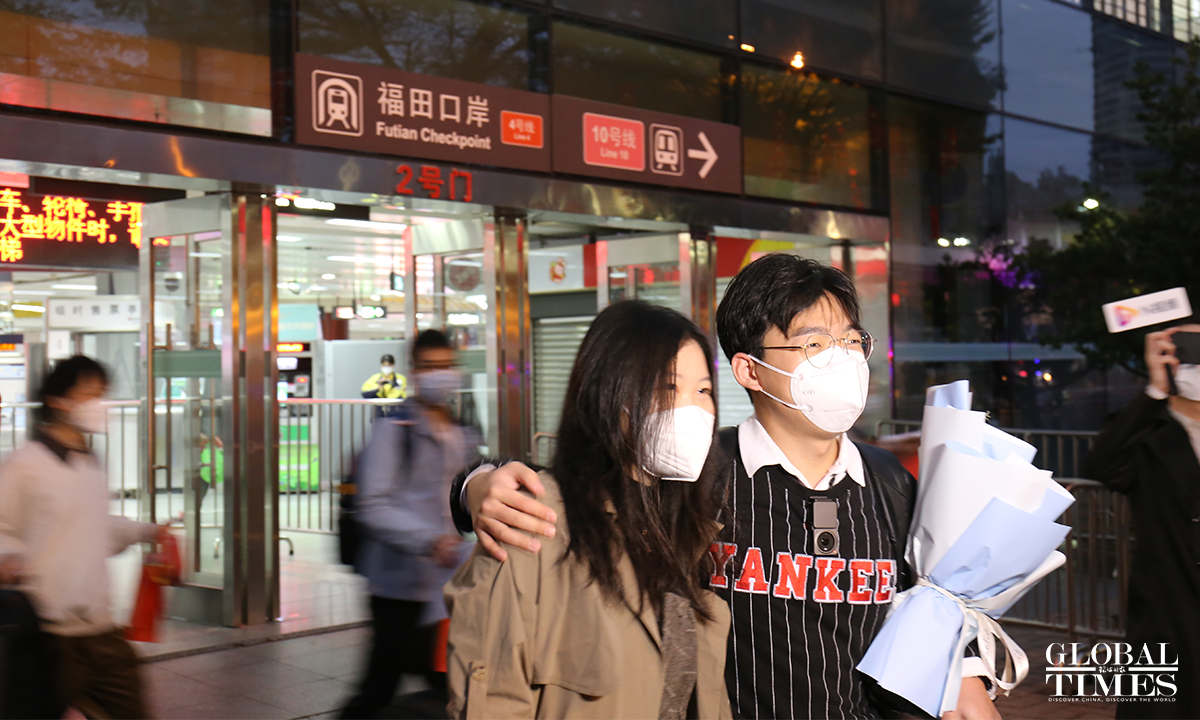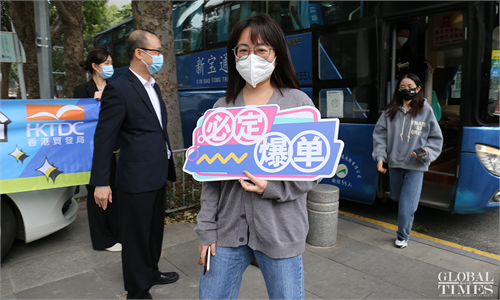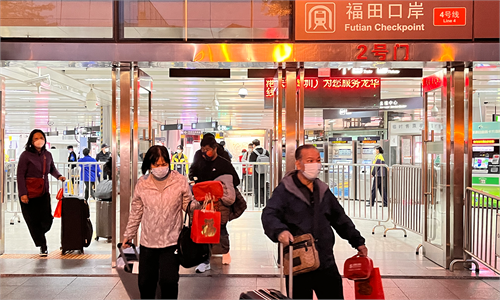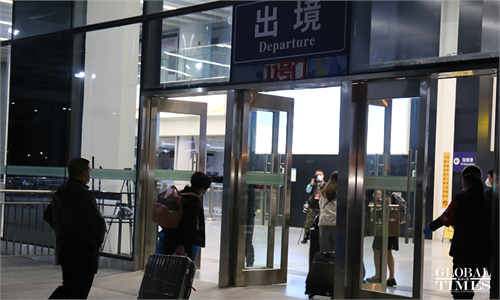Special bond between people in both mainland and HK only deepens after three years of closing off
Business, tourism and other industries about to see “new start” as normalcy resumes

Some 300 representatives from the Guangdong toy industry depart for the Hong Kong Toys & Games Fair from Shenzhen Bay Port on January 7, 2023. Photo: Zhao Juecheng/GT
Chinese mainland-Hong Kong border crossing points, having been closed due to the COVID-19 management for almost three years, reopened on Sunday, the first day China downgraded the management of the infectious disease from Class A to Class B.With the new policy in place, the warmth of hugging loved ones, the happiness of spending Chinese Lunar New Year with families, the excitement of visiting partners for businesses, and, most importantly, the reality of embracing "pre-pandemic normalcy," are palpable in the ports in Shenzhen that connect Hong Kong.
Apart from affections with family, friends and lovers been heated up by the border reopening, economic connections are also set to rekindle after normal exchanges are expected to be resumed soon. Business communities are gearing up to snap orders, the tourism industry is fully prepared to welcome travelers… The three-year closing off has not dampened the special bond that connects both sides, but only made people realize how deep the ties are across the borders, between the mainland and Hong Kong.
Several ports in Shenzhen, including Futian and Wenjindu, were decorated with red lanterns and flowers, sign boards such as "Welcome Home," "We are family" to welcome influx of arrivals from Hong Kong.
Most travelers reached by the Global Times hopped on the first train from Hong Kong to Shenzhen, just to meet their family as earlier as possible. They said they are excited that they can finally spend the Chinese Lunar New Year, the most important festival in Chinese culture, with their family following a three-year absence.
After hugging her husband at Futian port's exit, Ye could not let go of his hand. "This is our first meeting in person after more than two years. I was shocked how thin he has become when I saw him just now." Ye said she was struck by both hard feelings and excitement when she heard the news of border reopening between Hong Kong and the mainland. "I feel sad because it's been almost three years, thinking of all the time we spent apart, and excited as I can finally meet him again."
"It was just the usual hopping on and hopping off the train before, but three years of closing off made me realize how strong the bond between me and my beloved ones in Shenzhen, and also between Hong Kong and the mainland," a young man from Hong Kong who only gave his surname as Hung, told the Global Times on Sunday. Hung said he came to Shenzhen to visit his family.
The Hong Kong SAR government said on Saturday that more than 410,000 people in Hong Kong had registered to travel to the mainland as of Saturday afternoon.
When inspecting a Hong Kong checkpoint on Sunday, the city's chief executive John Lee Ka-chiu said that the first day of border crossing had gone smoothly and the daily quota will be scrapped in the future depending on how the situation unfolds.
Shenzhen authorities said that more than 1,600 individuals had registered to travel from Futian port to Hong Kong on Sunday. About 200 passengers are expected to enter Hong Kong through Wenjindu Port, and 700 from Hong Kong to Shenzhen, on the first day of the border reopening. The flow of passengers is expected to increase steadily in the coming days, said Tan Luming, an official from Shenzhen port office.
A fresh start
Hong Kong's financial secretary Paul Chan said on Sunday that the border reopening will inject greater impetus for the city's export, tourism, retail, and other industries.
A Shenzhen businessman surnamed Liu was among the first group traveling from Shenzhen to Hong Kong on Sunday morning. He told the Global Times that he had scheduled a meeting with his Hong Kong partners several hours later. "I applied for documents as soon as I saw the news that the border was reopening. I will go to Hong Kong as soon as possible to oversee the arrival of my goods…" Liu laughed light-heartedly. "Now that normal life is back, so should my business be."
Jim Zeng, the regional director of Hong Kong Trade Development Council based in Shenzhen, told the Global Times on Friday that border reopening could restart and further deepen the high-quality integration of the Great Bay Area and push for early implementation of Hong Kong's programs relating to enterprises, universities and research institutes, which has been postponed due to border closure.
Hong Kong could play a significant role of being an international partner, inviting leading overseas technology enterprises to the city and then connecting with technology enterprises in the mainland, said Zeng.
Some 300 representatives from the Guangdong toy industry have departed for the Hong Kong Toys & Games Fair from Shenzhen Bay Port on Saturday, holding great anticipation to meet up with their customers offline and strike deals after about three years of border closure.
Dozens of employees from a Shenzhen tourist company are also looking eagerly into helping their first group of clients cross the border from Hong Kong in three years. "It's been three years, so they are nervous and we are also nervous, as we both need to familiarize with the procedure of border crossing and everything again," an employee surnamed Huang told the Global Times. "But we are mostly happy. The tourism industry is finally seeing the first glimmer of hope!"
"No doubt I see strong confidence toward a fresh new and innovative Hong Kong starting from 2023 no matter from my personal perspective, or society of Shenzhen and Hong Kong or friends and enterprises from the two places," said Zeng.

A couple reunite at the Futian Checkpiont that bridge Shenzhen and Hong Kong on January 8, 2023. Photo: Zhao Juecheng/GT
Keeping COVID-19 on watch
When reporting on the Chinese mainland-Hong Kong border reopening, some foreign media have hyped the possibility that an influx of mainland arrivals could trigger great health risk in Hong Kong as the mainland is experiencing an exit wave.
However, officials as well as health experts have brushed aside such concerns. Speaking at a conference on January 5, the city's chief executive John Lee said that the 48-hour valid negative test, which is required for passengers traveling to and from both sides, is able to control such risks; moreover, the high rate of vaccination in Hong Kong - more than 2.5 million of the city's population - has formed an effective immune herd system to weather any imported COVID-19 danger.
Border opening with the mainland will not fuel COVID19 risks in Hong Kong as the city has already been infected with COVID-19 at a large scale and is able to buffer hazards coming from outside, said Jin Dongyan, a biomedical professor at the University of Hong Kong.
Tan, the Shenzhen port official, told the Global Times that for port working staff, apart from ensuring the smooth customs clearance, they should continue to carry out normal epidemic prevention and control work, for example, checking travelers nucleic acid testing. Everyone must wear masks, which is a long-term epidemic prevention policy, said Tan.






